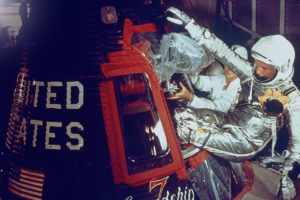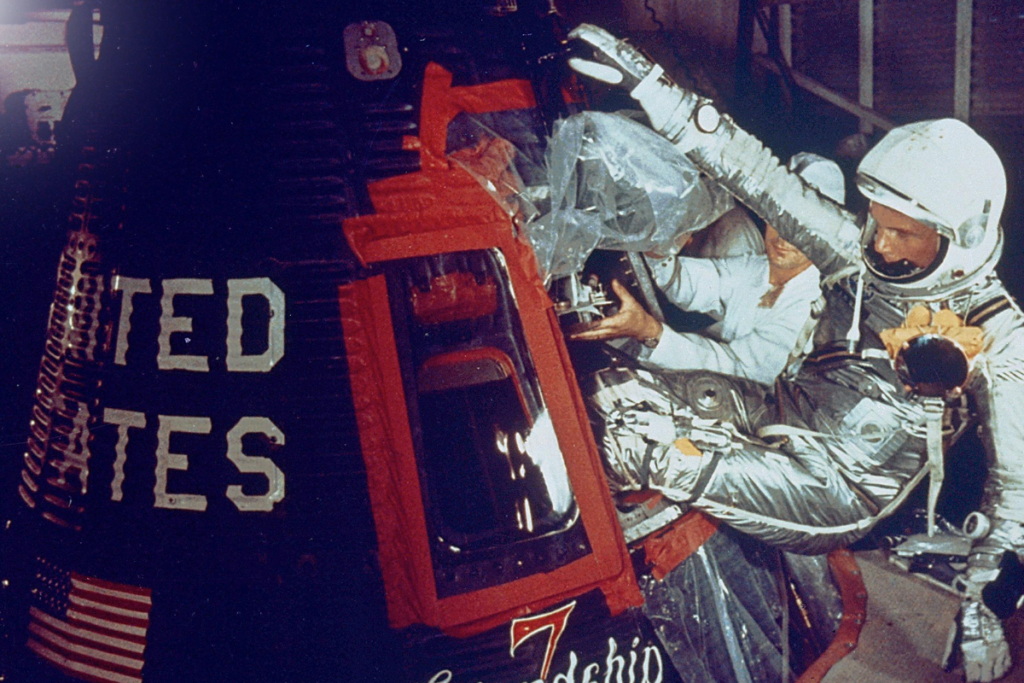When we think about the pioneers of space exploration, names like Neil Armstrong and Buzz Aldrin often come to mind. But before the famous moon landing, another American hero made history by orbiting the Earth. His name was John Glenn, and on February 20, 1962, he became the first American to circle the planet. Let’s dive into this monumental moment in history and explore how John Glenn’s achievement paved the way for the future of space exploration.
The Beginning of the Space Race
In the late 1950s, tensions between the United States and the Soviet Union reached new heights. This era, known as the Cold War, extended beyond just politics and military power—it became a race to conquer the final frontier: space. When the Soviet Union successfully launched the first human-made satellite, Sputnik, in 1957, it sent shockwaves across the world. The U.S. knew they had to catch up, and thus began the Space Race.
The Mercury Program
To challenge Soviet space dominance, NASA launched Project Mercury in 1958. The program’s aim was simple but ambitious: send an American into space, ensure their safety, and bring them back. Although the Soviet Union had already sent cosmonaut Yuri Gagarin into orbit in April 1961, the U.S. was determined to showcase its technological prowess by achieving the same feat.
Project Mercury’s Goals
The primary goals of Project Mercury were:
- Orbit a manned spacecraft around Earth.
- Investigate the ability of astronauts to function in space.
- Recover both the astronaut and spacecraft safely.
These objectives were ambitious, considering the limited technology of the time. Nevertheless, NASA was determined to make it happen.
Selection of Astronauts for Project Mercury
In 1959, NASA began its search for astronauts for the Mercury program. Known as the Mercury Seven, these men were selected from a group of military test pilots. They had the right blend of technical skills, bravery, and physical fitness to handle the rigors of spaceflight. John Glenn, a seasoned Marine Corps aviator, stood out as one of these elite individuals.
Meet John Glenn: The First American to Orbit Earth
John Glenn was born on July 18, 1921, in Cambridge, Ohio. From a young age, Glenn was fascinated by aviation. His passion for flying led him to become a Marine Corps fighter pilot during World War II and the Korean War. After his military service, Glenn became a test pilot, where he set a speed record flying from Los Angeles to New York in 1957. This background of excellence and courage prepared him for his ultimate mission: to be the first American to orbit the Earth.
Early Career of John Glenn
John Glenn’s military career was impressive. He flew 149 combat missions during World War II and the Korean War, earning numerous awards for his bravery and service. His skills as a fighter pilot and his calm demeanor under pressure made him a natural fit for NASA’s astronaut program.
John Glenn’s Preparation for Space
Before becoming the first American to orbit Earth, Glenn underwent extensive training. This included simulations of zero gravity, survival training, and rigorous physical conditioning. The stakes were high, and NASA couldn’t afford any mistakes. Glenn’s patience, dedication, and ability to handle stress were tested at every turn.
February 20, 1962: The Day of the Flight
On the morning of February 20, 1962, John Glenn strapped into the tiny Friendship 7 spacecraft, ready to make history. The mission had been delayed several times due to weather conditions, but now everything was set. Glenn was calm and composed, though the entire world was watching with bated breath.
As the Atlas rocket roared to life and lifted Friendship 7 off the launch pad, Glenn’s journey into the unknown began. His thoughts? “Zero G, and I feel fine,” Glenn calmly radioed to mission control as he reached orbit.
The Friendship 7 Spacecraft
Friendship 7 was small—about the size of a compact car. Inside, Glenn had little room to move as he circled the Earth. The spacecraft was equipped with instruments to monitor his vitals and spacecraft performance. It was built to handle the extreme temperatures of space and the fiery re-entry into Earth’s atmosphere.
The Journey Around Earth
Glenn orbited the Earth three times during his nearly five-hour mission. During each orbit, he experienced weightlessness, gazed down at the stunning view of the Earth’s surface, and monitored the spacecraft’s systems. He marveled at the beauty of the Earth, describing it as “breathtaking.” However, as thrilling as the mission was, it wasn’t without its challenges.
Challenges During the Mission
While Glenn’s mission was a monumental success, there were a few tense moments. One of the major concerns arose when a warning light indicated that Friendship 7’s heat shield might have come loose. This was a critical issue, as the heat shield was designed to protect Glenn from the intense heat generated during re-entry.
Heat Shield Concerns
To resolve the issue, NASA instructed Glenn to keep the retrorocket pack attached to the heat shield as he re-entered Earth’s atmosphere. This strategy worked, and Friendship 7 safely splashed down in the Atlantic Ocean, where Glenn was quickly recovered by the USS Noa, a Navy destroyer.
The Successful Return
Despite the challenges, John Glenn’s mission was a complete success. The safe return of both astronaut and spacecraft signified the U.S. had finally caught up with the Soviet Union in the Space Race. Glenn was celebrated as a national hero, with ticker-tape parades held in his honor in major cities like New York and Washington, D.C.

Impact of Glenn’s Mission on American Space Exploration
John Glenn’s successful orbit of Earth was a turning point in American space exploration. It demonstrated that the U.S. could send astronauts into space and bring them back safely. This mission boosted American confidence and laid the groundwork for the Apollo missions that would eventually land a man on the Moon.
John Glenn’s Legacy
John Glenn’s legacy as the first American to orbit Earth is undeniable. His bravery, determination, and dedication inspired a generation of astronauts and engineers. Glenn’s historic flight proved that space exploration was not just a dream—it was an achievable goal.
Life After Space for John Glenn
John Glenn’s career didn’t end with his spaceflight. He went on to serve as a U.S. Senator from Ohio for 24 years. But Glenn’s story didn’t stop there. At the age of 77, he returned to space aboard the Space Shuttle Discovery in 1998, becoming the oldest person to fly in space. His second spaceflight served as a scientific study on the effects of space travel on the elderly.
#DigitalTechTime #OrbitingSpaceStation #SatelliteOrbitsEarth #CleanTechStuff
Conclusion
John Glenn’s historic flight as the first American to orbit the Earth was a defining moment in the Space Race and in American history. His courage, perseverance, and commitment to pushing the boundaries of human achievement continue to inspire us today. Glenn’s journey wasn’t just about orbiting the Earth; it was about showing what’s possible when humans dare to reach for the stars.
FAQs
1. Why was John Glenn chosen for the Mercury mission?
John Glenn was selected for his exceptional skills as a pilot, his experience in combat, and his calm demeanor under pressure, all of which made him an ideal candidate for space travel.
2. How many times did John Glenn orbit the Earth?
John Glenn orbited the Earth three times during his historic flight on February 20, 1962.
3. What spacecraft did John Glenn fly in?
John Glenn flew in the Friendship 7 spacecraft during his mission to orbit the Earth.
4. What challenges did Glenn face during his mission?
One major challenge during the mission was a warning that the heat shield might have come loose, which could have endangered Glenn’s re-entry. Fortunately, the issue was resolved.
5. Did John Glenn return to space after his first mission?
Yes, John Glenn returned to space in 1998 at the age of 77 aboard the Space Shuttle Discovery, becoming the oldest person to fly in space.


